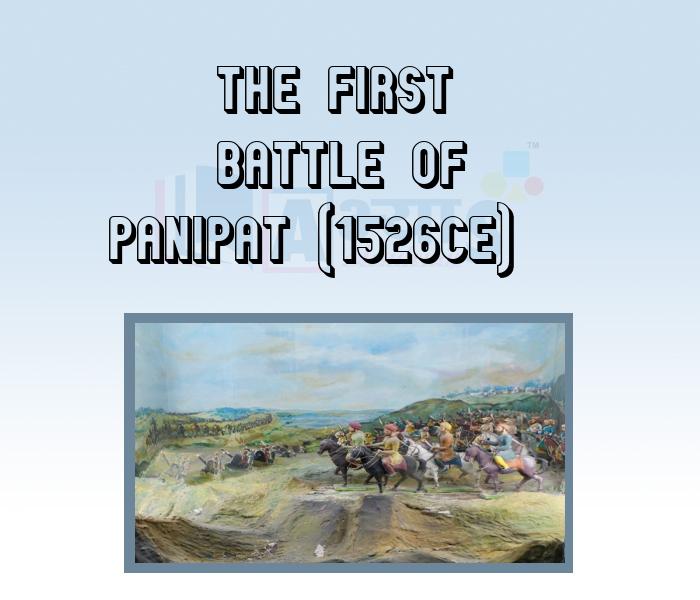The First Battle Of Panipat 1526 CE












The First Battle Of Panipat 1526 CE
Major campaigns and events
The First Battle Of Panipat (1526ce): Babur was a military genius who skillfully combined his artillery with his cavalry to win battles. The Indian soldiers were familiar with big guns but not the light field artillery and muskets used by Babur. Babur inflicted a crushing defeat on Ibrahim Lodi in the First Battle of Panipat in 1526 CE.
The first battle of panipat was fought between the invading forces of Babur and the Lodi Empire, which took place on 21st april1526 in North India. It marked the beginning of the Mughal Empire. This was one of the earliest battles involving gunpowder firearms and field artillery.
Advantages of Cannon in the Battle
It is generally held that Babur's guns proved decisive in battle, firstly because Ibrahim Lodi lacked any field artillary, but also because the sound of the cannon frightened Lodi's elephants, causing them to tremple Lodi's own men. However a reading of the contemporary sources show that more than the gun, It was the tacticts which helped in winning the day. the new war tactics introduced by Babur were the tulughma and the araba. Tulughma meant dividing the whole army into various units, the Left, the Right and the centre The Left and Right divisions were further subdivided into forward and rear divisions. Through this a small army could be used to surround the enemy from all the sides, the centre forward division was then provided with carts which were placed in rows facing the enemy and tied to each other with animal hide ropes. Behind them were placed cannons protected and supported by matelets which could be used to easily manoeuvre the canons. These two tactics made Babur's artillery lethal. The gun and cannons could be fired without any fear of being hit as they were shielded by the bullock carts which were held in place due to the hide ropes holding them together, the nozzle of the heavy cannons could also be easily changed as they could be manoeuvered by the mantelets which were provided with wheels.
Ibrahim Lodi died on the field of battle, abandoned by his feudatories and generals. Most of them changed their allegiance to the new master of Delhi. However had sultan ibrahim survived another hour of fighting he would have won, as Babur had no reserves and his troops were rapidly tiring.
Students / Parents Reviews [10]
It has a great methodology. Students here can get analysis to their test quickly.We can learn easily through PPTs and the testing methods are good. We know that where we have to practice

Barkha Arora
10thAbhyas is a complete education Institute. Here extreme care is taken by teacher with the help of regular exam. Extra classes also conducted by the institute, if the student is weak.

Om Umang
10thA marvelous experience with Abhyas. I am glad to share that my ward has achieved more than enough at the Ambala ABHYAS centre. Years have passed on and more and more he has gained. May the centre flourish and develop day by day by the grace of God.

Archit Segal
7thIt was good as the experience because as we had come here we had been improved in a such envirnment created here.Extra is taught which is beneficial for future.

Eshan Arora
8thOne of the best institutes to develope a child interest in studies.Provides SST and English knowledge also unlike other institutes. Teachers are co operative and friendly online tests andPPT develope practical knowledge also.

Aman Kumar Shrivastava
10thMy experience with Abhyas is very good. I have learnt many things here like vedic maths and reasoning also. Teachers here first take our doubts and then there are assignments to verify our weak points.

Shivam Rana
7thAbhyas Methodology is very good. It is based on according to student and each child manages accordingly to its properly. Methodology has improved the abilities of students to shine them in future.

Manish Kumar
10thBeing a parent, I saw my daughter improvement in her studies by seeing a good result in all day to day compititive exam TMO, NSO, IEO etc and as well as studies. I have got a fruitful result from my daughter.

Prisha Gupta
8thI have spent a wonderful time in Abhyas academy. It has made my reasoning more apt, English more stronger and Maths an interesting subject for me. It has given me a habbit of self studying

Yatharthi Sharma
10thAbout Abhyas metholodology the teachers are very nice and hardworking toward students.The Centre Head Mrs Anu Sethi is also a brilliant teacher.Abhyas has taught me how to overcome problems and has always taken my doubts and suppoeted me.
